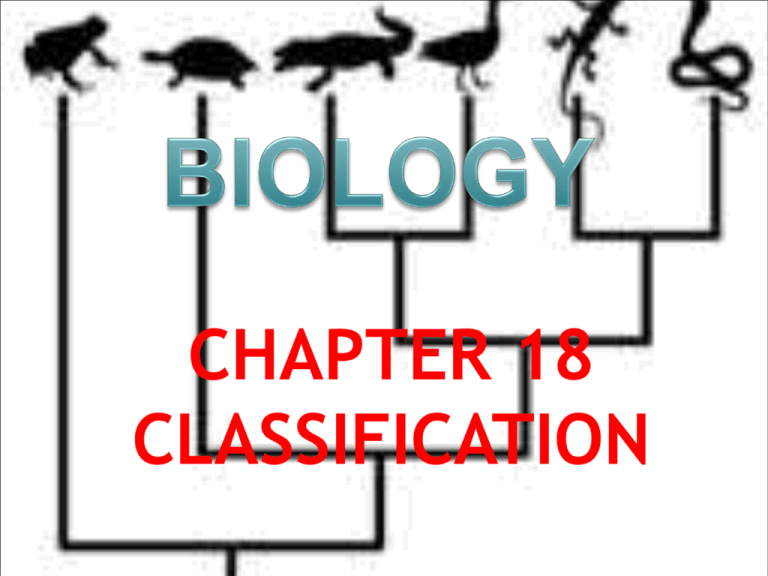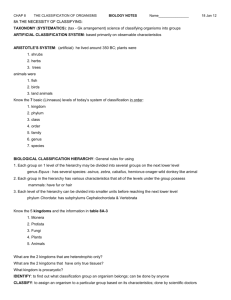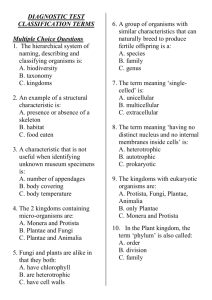
CHAPTER 18
CLASSIFICATION
18.1 Finding Order in Diversity
•
Classification – grouping of objects or information based
on similarities
•
Taxonomy – branch of biology for grouping and naming
organisms
Assigning Scientific Names
•
Scientific Names are written in Latin because:
•
The language is no longer used
•
The words stay the same and cannot change since
the language is dead
•
The words only have one meaning
Early efforts at naming organisms
•
Aristotle
•
Developed the first method of classification
•
Grouped them into 2 groups: plants and
animals
•
His system was useful but did not group
organisms according to their evolutionary
history
•
Linneaus
•
Developed binominal nomenclature system
•
Binominal Nomenclature – each species has a two
part name – genus & species
•
Based on structural and physical similarities of
organisms
•
He not only named species, he also grouped them
into categories.
•
Each level if called a taxon
•
Scientists realized there were enough differences among
organisms to make 5 kingdoms:
•
Monera - bacteria
•
Protista
•
Fungi
•
Plantae
•
Animalia
Copyright Pearson Prentice Hall
•
Six Kingdoms
•
Recently, biologists recognized that Monera were
composed of two distinct groups of bacteria
•
The six-kingdom system of classification includes:
•
Eubacteria
•
Archaebacteria
•
Protista
•
Fungi
•
Plantae
•
Animalia
Monera
Copyright Pearson Prentice Hall
•
The Three-Domain System
•
Molecular analyses have given rise to a new taxonomic
category that is now recognized by many scientists.
•
The domain is more inclusive category than any other-larger
than a kingdom.
•
The three domains are:
•
•
Eukarya –kingdoms protists, fungi, plants, and animals
•
Bacteria
•
Archaea
As new information is gained about organisms in the
domains Bacteria and Archaea, they may be subdivided into
additional kingdoms.
Copyright Pearson Prentice Hall
•
Domain Eubacteria
•
unicellular prokaryotes.
•
Thick or thin cell walls made of peptidoglycan
•
Ex: E. coli, cyanobacteria
Copyright Pearson Prentice Hall
Copyright Pearson Prentice Hall
•
Domain Archaea
•
unicellular prokaryotes.
•
live in extreme environments.
•
cell walls lack peptidoglycan, and cell
membranes contain unusual lipids not found
in other organisms.
•
Ex: thermophiles, haleophiles
Copyright Pearson Prentice Hall
•
Domain Eukarya
•
Unicellular and multicellular eukaryotes
•
This domain is organized into four kingdoms:
•
Protista
•
eukaryotic organisms that cannot be classified as
animals, plants, or fungi.
•
unicellular or multicellular
•
photosynthetic or heterotrophic
•
Live in moist environments
•
Ex: paramecium, kelp, slime mold
Copyright Pearson Prentice Hall
•
Fungi
•
heterotrophs.
•
Most fungi feed on dead or decaying organic
matter
•
multicellular (mushrooms) or unicellular
(yeasts)
•
some have cell wall composed of chitin
•
do not move from place to place
•
Ex: mushrooms, yeast, black mold
Copyright Pearson Prentice Hall
•
Plantae
•
Multicellular
•
photosynthetic autotrophs.
•
cannot move from place to place.
•
cell walls composed of cellulose.
•
includes cone-bearing and flowering plants as
well as mosses and ferns
Copyright Pearson Prentice Hall
•
Animalia
•
multicellular
•
heterotrophic.
•
do not have cell walls.
•
can move about
•
complex organ systems
Copyright Pearson Prentice Hall
BIO-QUIZ
18-3
1. Organisms whose cell walls contain
peptidoglycan belong in the kingdom
a.
b.
c.
d.
Fungi.
Eubacteria.
Plantae.
Archaebacteria.
18-3
2. Multicellular organisms with no cell walls or
chloroplasts are members of the kingdom
a.
b.
c.
d.
Animalia.
Protista.
Plantae.
Fungi.
18-3
3. Organisms that have cell walls containing
cellulose are found in
a.
b.
c.
d.
Eubacteria and Plantae.
Fungi and Plantae.
Plantae and Protista.
Plantae only.
18-3
4. Molecular analyses have given rise to a new
taxonomic classification that includes
a.
b.
c.
d.
three domains.
seven kingdoms.
two domains.
five kingdoms.
18-3
5. Which of the following contain more than one
kingdom?
a.
b.
c.
d.
only Archaea
only Bacteria
only Eukarya
both Eukarya and Archaea
•
Eight levels of classification are…
•
Domain – largest group of classification, a group of
related kingdoms
•
Kingdom – a group of related phyla
•
Phylum – a group of closely related classes
•
Class – a group of closely related orders
•
Order – a group of closely related families
•
Family – a group of closely related genera
•
Genus – a group of closely related species
•
Species
•
most specific level of classification
•
a group of organisms that can interbreed and
produce fertile offspring
Linnaeus's System of Classification
Grizzly Black Giant
bear
bear panda
Copyright Pearson
Sea
Hall
Red AbertPrenticeCoral
fox squirrel snake star
Movie
BIO-QUIZ
18-1
1. Which statement about classification is true?
a. Biologists use regional names for organisms.
b. Biologists use a common classification system
based on similarities that have scientific
significance.
c. Biologists have identified and named most
species found on Earth.
d. Taxonomy uses a combination of common and
scientific names to make the system more
useful.
18-1
2. Linnaeus's two-word naming system is called
a.
b.
c.
d.
binomial nomenclature.
taxonomy.
trinomial nomenclature.
classification.
18-1
3. Several different classes make up a(an)
a.
b.
c.
d.
family.
species.
kingdom.
phylum.
18-1
4. A group of closely related species is a(an)
a.
b.
c.
d.
class.
genus.
family.
order.
18-1
5. Which of the following lists the terms in order
from the group with the most species to the
group with the least?
a.
b.
c.
d.
order, phylum, family, genus
family, genus, order, phylum
phylum, class, order, family
genus, family, order, phylum
•
Did King Phillip Come Over For Great Spaghetti
•
Proper way to write a scientific name
•
All letters are lower case except the genus is
capitalized.
•
Genus and species is underlined or italicized
•
Ex. eukarya, animalia, chordate, mammalia,
primata, hominidae, Homo, sapien
•
Dichotomous Key
•
A set of paired statements used to help
identify organisms
•
Read each statement and decide which fits
your organism
•
Go to where that statement tells you and read
the next two statements
•
Eventually you will reach a statement that tells
you the name of the organism
Choose one of the items from the following list: pine tree,
clam, rock, robin, tin can, deer, oak tree, mouse, dandelion,
Paramecium, bicycle, ant
1. a. Organism is living....................................go to 4.
1. b. Organism is nonliving........ ....................go to 2.
2. a. Object is metallic.....................................go to 3.
2. b. Object is nonmetallic................. ..............Rock.
3. a. Object has wheels..............................Bicycle.
3. b. Object does not have wheels..............Tin Can.
4. a. Organism is microscopic...........Paramecium.
4. b. Organism is macroscopic........................go to 5.
5. a. Organism is a plant.................................go to 6.
5. b. Organism is an animal............................go to 8.
6. a. Plant has a woody stem.........................go to 7.
6. b. Plant has a herbaceous stem......... .Dandelion.
7. a. Tree has needle like leaves..............Pine Tree.
7. b. Tree has broad leaves......................Oak Tree.
8. a. Organism lives on land.........................go to 9.
8. b. Organism lives in water...........................Clam.
9. a. Organism has 4 legs or fewer.............go to 10.
9. b. Organism has more than 4 legs................Ant.
10 a. Organism has fur................................go to 11.
10 b. Organism has feathers.........................Robin.
11 a. Organism has hooves............................Deer.
11 b. Organism has no hooves......................Mouse
18.2 Modern Evolutionary Classification
Evolutionary Classification
•
Phylogeny – evolutionary relationships among organisms.
•
Biologists currently group organisms into categories that
represent lines of evolutionary descent, or phylogeny, not
just physical similarities.
•
The higher the level of the taxon, the further back in time
is the common ancestor of all the organisms in the taxon.
•
Organisms that appear very similar may not share a
recent common ancestor.
•
Classification Using Cladograms
•
Cladogram – a branching diagram showing the
evolutionary relationships among a group of
organisms
•
Traits that appear in recent parts of a lineage but not
in its older members are called derived traits
•
Derived traits can be used to construct a cladogram
•
Cladograms help scientists understand how one
lineage branched from another in the course of
evolution
EUBACTERIA
ARCHAEBACTERIA
EUKARYOTES
Fig. 20.17, p. 327
BIO-QUIZ
18-2
1. Grouping organisms together based on their
evolutionary history is called
a.
b.
c.
d.
evolutionary classification.
traditional classification.
cladogram classification.
taxonomic classification.
18-2
2. Traditional classification groups organisms
together based on
a.
b.
c.
d.
derived characters.
similarities in appearance.
DNA and RNA similarities.
molecular clocks.
18-2
3. In an evolutionary classification system, the
higher the taxon level,
a. the more similar the members of the taxon
become.
b. the more common ancestors would be found in
recent time.
c. the fewer the number of species in the taxon.
d. the farther back in time the common ancestors
would be.
18-2
4. Classifying organisms using a cladogram
depends on identifying
a. external and internal structural similarities.
b. new characteristics that have appeared most
recently as lineages evolve.
c. characteristics that have been present in the
group for the longest time.
d. individual variations within the group.
18-2
5. To compare traits of very different organisms,
you would use
a.
b.
c.
d.
anatomical similarities.
anatomical differences.
DNA and RNA.
proteins and carbohydrates.









